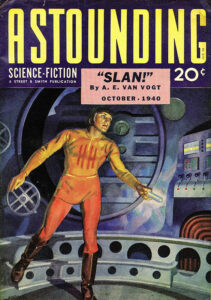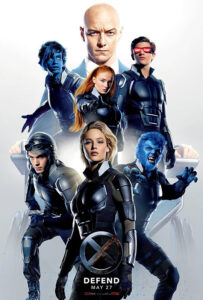When the X-Men first burst onto the scene in 1963, their story — about a group of mutant kids with weird powers — introduced a new kind of superhero. The superheroes who’d come before them were loved by society, but the X-Men were shunned for their strange powers and weird appearances.
In a few months, the latest movie in the X-Men series, X-Men: Apocalypse, will also find humans and mutants at odds.
While many — including the writer of the Vox piece — may think that this theme originated in the Marvel Comics back in the 1960s, it’s actually much older. Let’s go back 75 years to the pulp magazine Astounding.
From September through December 1940, A.E. van Vogt‘s story Slan was serialized in four parts in Astounding. In 1946, Arkham House published a slightly revised version as a hardcover, van Vogt’s first book.

Slan follows a mutant boy, Jommy Cross, as he skirts capture by the human authorties. The humans feel threatened by the mutants, called “slans,” who are smarter and stronger. But the slans themselves are divided by a war between those who have telepathic abilities and those who don’t.
The novel spans decades, as Jommy grows into an adult and explores the boundaries of the humans and the mutants, battling both at times. In Slan, as in X-Men, there are both good and bad slans — who, by the way, are called a portmanteau of their creator’s name, Samuel Lann. Some mutants who want to destroy or enslave the humans as much as the fearful humans want to destroy the slans, while other slans want to live in peace among the humans.
In But Without Horns, there’s even more conflict between humans and mutants. But Without Horns is a novella written by Norvell W. Page for the pulp Unknown. It appeared in Unknown‘s June 1940 number.
Of course, Page is better known today for the non-stop, violent adventures he wrote for The Spider pulp. And But Without Horns isn’t that much different in that sense.
The novel opens in media res with the murders of FBI agents in a midwestern city and FBI headquarters in Washington, D.C., in an apparent state of siege, with the director holed up in his office. Fortunately, Walter Kildering, a gray-eyed, analytical agent, has already figured out what’s going on and identified the mysterious “Unknown” who seems to be killing at will and at great distances with a mysterious “Blue Death.”
(I thought it was humorous that Page nicknamed the villian “Unknown,” which of course was the name of the pulp. Apparently Page, like van Vogt, had written the story in answer to a challenge by the magazine’s editor, John W. Campbell, that no one could write a novel about a believable superman.)
Miller has deduced the Unknown to be someone named John Miller:
As to what he is— undoubtedly, a mutant of the human species. …
“(He’s) a monster” — Kildering’s voice was soft — “or a superman. Different from the human species, but sprang from it, as men and apes sprang from the mutations of a single primordial species.”
“And this time, we’re the apes, huh?” (FBI Agent Bill) Mayor rasped. “He’s got to be destroyed!”
Miller is an evil twist to the X-Men’s Professor Xavier‘s powers and Magneto‘s motivations. Not only can he murder individuals from a distance using his mind, but, by somehow amplifying his powers through the electrical grid, Miller is also able to kill off a whole swath of people in a midwestern city whom he “did not deem smart enough to live.” Miller takes control of the city, then begins expanding his territory. Kildering fears that Miller won’t stop until he controls the entire country.

What makes the novel so interesting is that you never actually come face-to-face with Miller. He’s always out of the frame, so to speak, with Kildering and his two loyal agents always in pursuit, always just behind the smarter Miller.
Beside enslaving humans, Miller wants to breed a new population of mutants. At one point, Kildering wonders how many more mutants might be out there.
The X-Men stories reflect the same us-versus-them mutant theme that was already fully formed in the stories by van Vogt and Page in the early 1940s.
I’ve read both novels in the past month. Slan and, in particular, But Without Horns clearly fall into the written-for-the-pulp-magazines category of storytelling. Both focus on action and moving the plot along, with little attention paid to mood-setting descriptions, characterization, or anything but cursory motivations. But if you go in expecting that, rather than more “literary” work, then you can easily enjoy the stories.
The issues with both stories are available as scanned files online with a bit of searching.
Both are worth reading because they inspired an aspect of today’s pop culture, the X-Men and similar mutant stories. In fact, most popular genres found in everything from comics and fiction to movies and TV were created — or at least coalesced — in the pulp magazines.


A couple years before the X-Men appeared in Marvel, the German pulp-like magazine Perry Rhodan, a space opera series, featured the spacefaring hero assembling a group of mutants to fight for him. In addition after a handful of weekly issues, the ‘good’ mutants battled “The Mutant Master” who had assembled a mutant group of his own to oppose Rhodan’s mutants. I’ve often wondered if Stan Lee had heard about the series in the early ’60s.
That’s a good question about Stan Lee. Forrest J Ackerman didn’t introduce the translated editions of Perry Rhoda until the late ’60s. So if Lee had, it would have been from the German language versions.
The only thing that would have made this revelation better is if those two sources had been published in one of the Donenfeld’s old magazines instead of Street & Smith.
Nice article William. Slan was the first story that came to my mind, it has been decades since I read that one. But Without Horns by Page is a favorite of mine.
What a delight! As an old SF buff I certainly knew about “Slan,” but what an added treat that the “Spider” scribe put in his contribution to mutant mythology…
The original X-Men comic (https://en.wikipedia.org/wiki/Uncanny_X-Men) was co-created in 1963 by Jack Kirby and Stan Lee. The latter might have — as he tells it — come up with the whole concept on his own. But the comicscenti are aware how Kirby (the greatest comics creator of all time, and that’s no hype) came up with huge amounts of characters, concepts, plots, and dialogue. And as usual in their collaborations, Lee claimed credit and full payment as the writer.
One wonders how much Kirby actually was the prime mover behind the X-Men. He told how science-fiction pulps blew his imagination wide open:
—————————-
Jack was also a lifelong pulp magazine collector, and a huge fan of the artwork of Shadow-illustrator Edd Cartier! “The pulps were my writing school,” Jack recalled. His love of pulps and science fiction began when he found an abandoned, waterlogged copy of the December 1932 issue of WONDER STORIES: “It had been raining. I spotted this magazine floating down the gutter and jumped for it. The cover was amazing! I’d never seen anything like it, spaceships and fantastic cities. At that moment, something galvanized in my brain.” It was the Golden Age of science fiction pulps that triggered Kirby’s imagination and creativity. While he achieved his greatest fame in comic art, he remained a devoted fan and collector of vintage science fiction pulps for the rest of his life. “Crazy as it sounds, pulp magazines are my collectibles!” he insisted…
—————————-
https://www.facebook.com/sanctumbooks/posts/1002132526493338
Kirby even contributed some pulp illustrations as a sideline to his comics work; mainly in 1940-41. (See http://www.tcj.com/reviews/the-secret-history-of-marvel-comics-jack-kirby-and-the-moonlighting-artists-at-martin-goodmans-empire/ )
What were the years those mutant tales were published? “Slan” was in the 1940 “Astounding,” “But Without Horns” in “Unknown” that year.
Could Jack Kirby have read those while illustrating SF pulps that very same year? Food for thought…
I met Jack Kirby at Phil Seuling’s original 1967 ComiCon. He told me how much he loved reading pulps, so it’s possible.
Van Vogt followed “Slan” with a whole race of supermen, mutated by a matter transporter to greater mental powers of will and intelligence. These are the “Dellian
Supermen” who have fled persecution in the Milky Way Galaxy to hide in the Greater Megellanic Cloud. The stories from 1945 Astoundings were collected in Gnome Press’ “The Mixed Men” and the softcover “Mission to the Stars”.